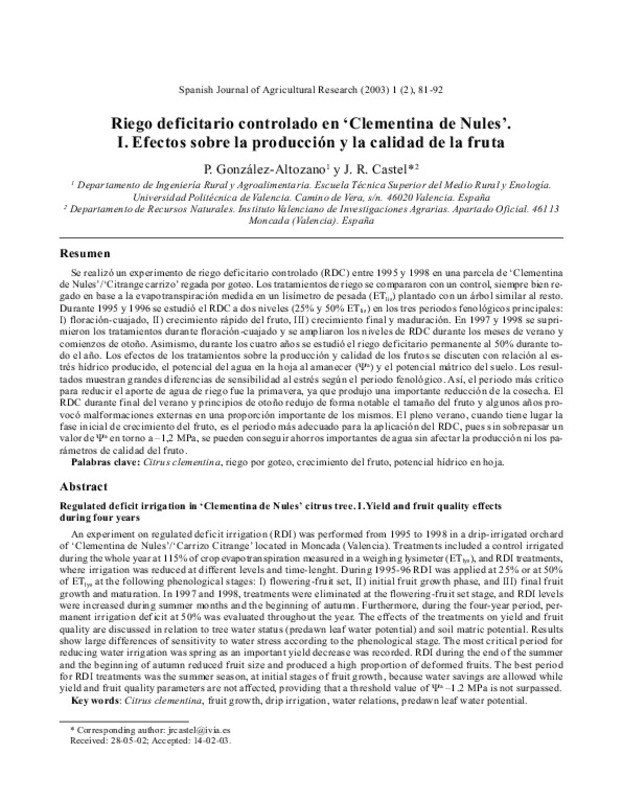JavaScript is disabled for your browser. Some features of this site may not work without it.
Buscar en RiuNet
Listar
Mi cuenta
Estadísticas
Ayuda RiuNet
Admin. UPV
Riego deficitario controlado en 'Clementina de Nules'. I. Efectos sobre la producción y la calidad de la fruta
Mostrar el registro sencillo del ítem
Ficheros en el ítem
| dc.contributor.author | González Altozano, Pablo
|
es_ES |
| dc.contributor.author | Castel, J. R.
|
es_ES |
| dc.date.accessioned | 2024-02-28T19:04:42Z | |
| dc.date.available | 2024-02-28T19:04:42Z | |
| dc.date.issued | 2003-06-01 | es_ES |
| dc.identifier.issn | 1695-971X | es_ES |
| dc.identifier.uri | http://hdl.handle.net/10251/202839 | |
| dc.description.abstract | [EN] An experiment on regulated deficit irrigation (RDI) was performed from 1995 to 1998 in a drip-irrigated orchardof "Clementina de Nules"/"Carrizo Citrange" located in Moncada (Valencia). Treatments included a control irrigated during the whole year at 115% of crop evapotranspiration measured in a weighing lysimeter (ETlys), and RDI treatments, where irrigation was reduced at different levels and time-lenght. During 1995-96 RDI was applied at 25% or at 50% of ETlys at the following phenological stages: I) flowering-fruit set, II) initial fruit growth phase, and III) final fruit growth and maturation. In 1997 and 1998, treatments were eliminated at the flowering-fruit set stage, and RDI levelswere increased during summer months and the beginning of autumn. Furthermore, during the four-year period, permanent irrigation deficit at 50% was evaluated throughout the year. The effects of the treatments on yield and fruitquality are discussed in relation to tree water status (predawn leaf water potential) and soil matric potential. Resultsshow large differences of sensitivity to water stress according to the phenological stage. The most critical period for reducing water irrigation was spring as an important yield decrease was recorded. RDI during the end of the summer and the beginning of autumn reduced fruit size and produced a high proportion of deformed fruits. The best period for RDI treatments was the summer season, at initial stages of fruit growth, because water savings are allowed while yield and fruit quality parameters are not affected, providing that a threshold value of a 1.2 MPa is not surpassed. | es_ES |
| dc.language | Español | es_ES |
| dc.publisher | Instituto Nacional de Investigacion y Tecnologia Agraria y Alimentaria | es_ES |
| dc.relation.ispartof | Spanish Journal of Agricultural Research | es_ES |
| dc.rights | Reconocimiento (by) | es_ES |
| dc.subject | Citrus clementina | es_ES |
| dc.subject | Riego por goteo | es_ES |
| dc.subject | Crecimiento del fruto | es_ES |
| dc.subject | Potencial hídrico en hoja | es_ES |
| dc.subject | Fruit growth | es_ES |
| dc.subject | Drip irrigation | es_ES |
| dc.subject | Water relations | es_ES |
| dc.subject | Predrawn leaf water potential | es_ES |
| dc.subject.classification | INGENIERIA AGROFORESTAL | es_ES |
| dc.title | Riego deficitario controlado en 'Clementina de Nules'. I. Efectos sobre la producción y la calidad de la fruta | es_ES |
| dc.title.alternative | Regulated deficit irrigation in 'Clementina de Nules' citrus trees.: I.: Yield and fruit quality effects | es_ES |
| dc.type | Artículo | es_ES |
| dc.identifier.doi | 10.5424/sjar/2003012-24 | es_ES |
| dc.relation.projectID | info:eu-repo/grantAgreement/CICYT//HID96-1342-C04-04//RESPUESTA DE LOS ÁRBOLES FRUTALES AL RIEGO DEFICITARIO: UTILIZACIÓN DE INDICADORES BIOLÓGICOS PARA LA OPTIMIZACIÓN DEL RIEGO/ | es_ES |
| dc.relation.projectID | info:eu-repo/grantAgreement/INIA//SC93-059-06//RESPUESTA DE LOS CULTIVOS AL RIEGO DEFICITARIO Y DETERMINACIÓN DE SUS NECESIDADES HÍDRICAS/ | es_ES |
| dc.relation.projectID | info:eu-repo/grantAgreement/EUREF//FAIR1-CT95-0030//INNOVATIVE BIOLOGICAL INDICATORS TO IMPROVE THE EFFICIENCY OF WATER AND NITROGEN USE AND THE FRUIT QUALITY IN TREE CROPS/ | es_ES |
| dc.rights.accessRights | Abierto | es_ES |
| dc.contributor.affiliation | Universitat Politècnica de València. Escuela Técnica Superior de Ingeniería Agronómica y del Medio Natural - Escola Tècnica Superior d'Enginyeria Agronòmica i del Medi Natural | es_ES |
| dc.description.bibliographicCitation | González Altozano, P.; Castel, JR. (2003). Riego deficitario controlado en 'Clementina de Nules'. I. Efectos sobre la producción y la calidad de la fruta. Spanish Journal of Agricultural Research. 1(2):81-92. https://doi.org/10.5424/sjar/2003012-24 | es_ES |
| dc.description.accrualMethod | S | es_ES |
| dc.relation.publisherversion | https://doi.org/10.5424/sjar/2003012-24 | es_ES |
| dc.description.upvformatpinicio | 81 | es_ES |
| dc.description.upvformatpfin | 92 | es_ES |
| dc.type.version | info:eu-repo/semantics/publishedVersion | es_ES |
| dc.description.volume | 1 | es_ES |
| dc.description.issue | 2 | es_ES |
| dc.relation.pasarela | S\25196 | es_ES |
| dc.contributor.funder | EUREF | es_ES |
| dc.contributor.funder | Instituto Nacional de Investigaciones Agrarias | es_ES |
| dc.contributor.funder | Comisión Interministerial de Ciencia y Tecnología | es_ES |








